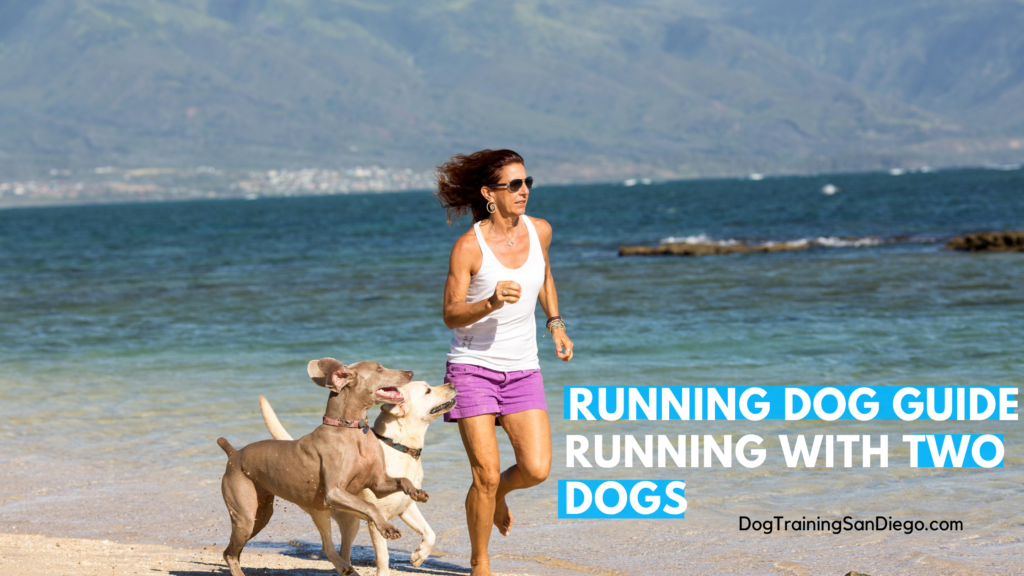Running is one of the greatest ways to get fit. (Update Aug 2020)–> with the gyms closed, spin classes and camps cancelled, the outdoors is an outlet that’s easily available to us. Dogs absolutely love to go and need the exercise just as much as we do. In fact those of you who just got dogs, you’ll find that running with your dog is a motivator, even on the days you don’t feel like it.
Running with one dog is an entire different story than running with two dogs. Running with two dogs has challenges. I’m here to dispel the challenges and excuses and get you out there running with your dogs.
It’s frustrating when you feel like:
- It’s hard to take both dogs because they pull
- I can’t leave one dog here, she doesn’t like it
- Maybe I should wait until they are older and trained better
- One dog is big, one is little, don’t think they can go the same pace
- Next week the weather will be better
- Need to get a new leash I can hold on to
I know these can be frustrating but with a few tips and changing up the way you view training your dog to run with you will make this more fun for everyone. It’s really about getting out there, moving with your dogs and playing games that end up in a running routine. Your dogs become great running partners by stringing some short play sessions into longer run sessions.
Running with Two Dogs – Getting Started
First, let’s establish that it is perfectly okay to take one dog at a time when you start with a running routine. In fact you should be setting up some alone time for each dog for several reasons.
Dogs think and learn in pictures and by doing an action repeatedly. Keeping that in mind, if both dogs are pulling on the leash, you’ll need to back up and show each one what it’s like to run with you on a loose leash. Trying to show both dogs at the same time is asking a lot of you and a lot of the dogs so don’t set yourself or your dogs up to be frustrated.
At the time of this article update, it’s more important than ever to do a few things separately with your dogs so that you don’t end up with a case of separation anxiety. Once your home office is vacated to go back to working in an office, going to school or being away from your home for other reasons, you’ll want your dogs to be perfectly fine while not stuck to your side.
Even better, you can use this concept in the beginning to get yourself out there moving just a little more by taking each dog, one at a time. The switch-a-woo game works. Shorten your route with the first dog, make a loop and come around and get the second dog. With some consistent practice each dog will become a better running partner and the time will come to run with both of them together.
Dog Leash and Collar Running Equipment
A 6 foot leash is the standard but when running with two dogs, I use a shorter leash for both dogs. It keeps your dog near you and it doesn’t allow the two dogs to cross up the leashes which can cause tangling and tripping.
This video, done a long time ago, still holds true today. If you are using a 6 foot leash shorten them up and keep your dog near you. Do this technique with each dog consistently so they get success on a loose leash and then do the same technique with both dogs.
There are many options when it comes to collars and harnesses to use while running with your dog and many reasons why you’d want to use different styles. Some dogs are deeply ingrained in the pulling behavior. Certain types of collars used correctly can help with the training process. Flat collars, martingale collars, ecollars, prong collars are all options, but some of those options do require specific training so that they are used effectively and correctly. If you’ve got a tough case of pulling going on, and the exercise below isn’t getting it for you, I invite you to get on a private running with dogs online session with me so you can get out there and run with your dog sooner than later.
The Game: Loose Leash Running With Your Dog
Here’s how to play the leash training game…
- Practice in an area you have room to move in all directions – We get distracted easily. So do our dogs. And so far, the experience of walking down the sidewalk or on a trail in one direction isn’t working. So use an area you have a bit of room to move. It could be your front or back yard, the driveway, a park or in this case the beach. Note there’s a bit more distraction in the video that I recommend to start out your first few sessions, but you get the idea. Don’t start out in an area that there’s lots of competition for your dog’s attention.
- Keep the initial training sessions short – This isn’t a 2 mile long walk, or a 5K or even on a sidewalk, in a straight line with a destination in mind. This is a 10 minute session which is fun, and teaches my dog to pay attention to me no matter what direction I’m walking in. Even world champions will tell you that the key to their training was slowing down, doing drills and getting it right. Build that foundation and you can go for time, distance, speed… whatever your goals for you and your dogs are.
- Don’t move in a straight line – The goal here is to get your dog to pay attention. Change directions often. You can even back up. Notice I also stop with him, gain his complete attention, then move forward again. These drills will help you lengthen out the time your dog pays attention in forward movement. Fundamentals first. And yes, you may feel like you are backing way up here. That’s okay. A solid foundation will move you forward faster in the long run.
- Move AWAY from your dog – As soon as you notice your dog isn’t engaged move away from him. The moment your dog starts checking something else out, move away from him. This encourages your dog to start playing your game… pay attention to you. It encourages your dog to follow you instead of pulling away from you. Dogs do love when they get it right and repetition in this game will teach your dog to stay with you instead of pulling ahead.
- Start on pavement – There are all sorts of smells in sand and grass and on trails. And dogs love smell. So start in an area where they don’t have the distraction of their nose (which is a huge part of how they navigate in a new area). Teach the basics in the beginning with as little distraction as possible. *The video above is at the beach… don’t start there. I’m a trainer and I’ve been doing some other work with this wild Wieimy!
Running Motivation
Dogs are better than gyms. In these times we’re finding that out. The silver lining of “stay at home” and gym closures is getting outdoors. Dogs love routine. They love movement. They love to “go”.
If you’ve got frustration with leash pulling when it comes to two dogs, you’ve got a double reason to get yourself out there practicing these exercises. Life as we knew it has changed forever and the idea that we have to create our own outdoor gym is our reality. Spending time every day teaching this skill so that you can run with your dogs is well worth it.

